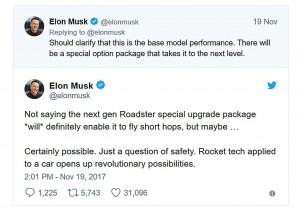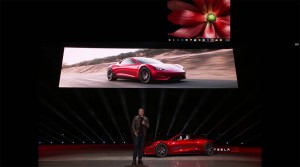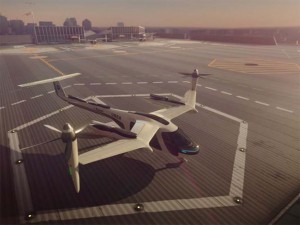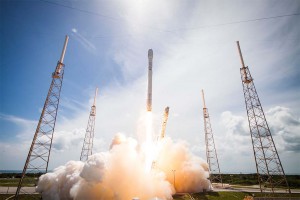What happens when the head of your car company also runs a rocket business? If that person happens to be CEO Elon Musk he hints that the new, $200,000 Roadster Tesla unveiled last week also may be able “to fly for short hops” if a buyer opts for a “special upgrade.”
Musk isn’t the only one who envisions flying cars. A number of firms are working on that concept, including European aerospace giant Airbus. But the Sunday tweet by the Tesla CEO adds another twist to the tale of a company that not only is building cars but batteries, stationary power systems and solar cells. Musk is also the boss at SpaceX, the rocket company that has been supplying the International Space Station and soon plans to start launching humans into space under contract for NASA.
Whether the latest tweet is serious is a question generating plenty of buzz across the Internet. While Musk’s many fans seem to believe he’s capable of just about anything, skeptics are asking whether the hint of a flying Tesla Roadster might be meant to divert attention away from the carmaker’s struggles – which include a disastrous third-quarter loss and ongoing problems getting the new Model 3 into volume production.
“Not saying the next gen Roadster special package *will* definitely enable it to fly short hops, but maybe,” Musk tweeted on Sunday, adding, “Certainly possible. Just a matter of safety. Rocket tech applied to a car opens up revolutionary possibilities.”
 Tesla’s first commercial product was a two-seat Roadster, and it has been hinting a new version was under development. Nonetheless, it came as a major surprise when, during an event officially scheduled to reveal the new battery-powered Tesla Semi truck, Musk also unveiled the new Roadster, as well.
Tesla’s first commercial product was a two-seat Roadster, and it has been hinting a new version was under development. Nonetheless, it came as a major surprise when, during an event officially scheduled to reveal the new battery-powered Tesla Semi truck, Musk also unveiled the new Roadster, as well.
The specs announced last Thursday evening were impress, even for a down-to-earth vehicle, Tesla claiming the Roadster will hit 60 in just 1.9 seconds yet still manage over 600 miles range using a 250 kWh battery pack.
(Tesla bills new Roadster as “world’s fastest production car. Click Here to check it out.)
But a flying version? That has been a dream for more than a century, automotive pioneer Henry Ford funding development of a flying Model T until a friend, also the company’s lead test pilot, crashed. Lately, there has been a windstorm of interest in the concept, a number of companies working on new designs that could get off the ground in the next few years. They range from MIT spin-off Terrafugia to Toyota and even Airbus. Uber this month announced plans to begin testing its flying taxi service by 2020, with a goal of launching service in time for the 2028 Olympics in Los Angeles.
(Click Here for more on Uber’s air taxi plans.)
If anything, Musk seemed the skeptic when he participated in the TED Talks earlier this year, warning of flying cars that “they’ll be quite noisy,” and adding that if “there’s a whole bunch of flying cars going all over the place, that is not an anxiety-reducing situation.”
Has Musk really changed his mind? And, if so, how will the Roadster fly? Many of the new flying car and taxi concepts will make use of electric motors, rather than the traditional gas or kerosene fuels the aircraft industry has traditionally relied upon. With a 250 kWh lithium-ion battery pack the Roadster would have a lot of energy onboard. But the Musk tweet hints at “rocket tech,” which appears to point towards technology derived from SpaceX.
While it’s the stuff of sci-fi adventures, It’s hard to imagine bolting a set of rockets onto the new Roadster. And, for anyone who admires Tesla’s emphasis on emissions-free technology, rockets are not only energy hogs but can be rather dirty, depending upon what fuel is used.
Of course, the bigger question is whether Musk is serious about a flying Roadster. While it still boasts a stock price other automakers only can dream about, shares of TSLA shares are more than $60 off from their $389.61 record high of a few months ago. The stock collapsed after Tesla revealed a $2.92 per-share loss for the third quarter, compared with a consensus forecast of $2.45.
(Why did Tesla earnings fare so poorly? Click Here to find out.)
A number of analysts have turned bearish. Among the more consistent Teslas critics has been Efraim Levy, of CFRA Research. While the Semi and Roadster “are potential game-changers for TSLA,” he is advising investors, “first various financial, timing, and other questions must be resolved for the trucks and the Model 3.”
Former General Motors car czar and Vice Chairman Bob Lutz also weighed in during an appearance on CNBC Friday. Though a proponent of battery power – and credited with the concept behind the Chevrolet Volt plug-in hybrid – Lutz declared Tesla a “losing enterprise,” insisting that “at this rate they’ll never get to 2019.”
The Semi isn’t due out until that year, Tesla said last week, with the Roadster due to follow in 2020. For now, the big challenge the company faces is actually building the Model 3. The sedan did become the first Tesla product to go into production on time last July. But, since then, the company’s Fremont, California assembly plant has been facing what Musk has described as “production hell,” and is currently turning out barely 10% of the Model 3s Tesla had planned. Meanwhile, reports indicate many of those vehicles have significantly quality issues.
Tesla had hoped to boost total production to 500,000 next year, or about an eight-fold increase over 2018. But during an earnings conference call, Musk and other company officials acknowledged it will be well into the coming year before they can fully overcome the production mess. And Tesla is currently putting on hold the investments it still needs to make to get Model 3 up to full line speed.
While the carmaker claims to have more than 300,000 advance reservations in hand, if it can’t start filling orders and collecting sales revenues it very well could crash and burn before the Roadster can ever get off the ground.
(For a first look at the Tesla Semi, Click Here.)




“With a 250 kWh lithium-ion battery pack the Roadster would have a lot of energy onboard.”
Obviously Paul is not familiar with electric cars – a 250 kWhr battery pack would weigh well over 2000 pounds, and provide a driving range for a car as small as Tesla’s misnamed “roadster” (it’s not really a roadster, Paul) over 900 miles, not the 620 claimed by Musk. As GM’s Bob Ltuzrecently pointed out , Tesla has no technological advantages over any automaker, much less the global guys, all of whom can buy
the same electric motors and the same batteries as Tesla – and do things even much better than Tesla – witness the recent demonstration by Porsche of their ability to recharge their new Mission e electric in half the time required by a Tesla vehicle’s supercharger protocol.
LOL, Kent, I have been following electric cars for over 30 years, and I’d say my knowledge of the tech is substantial. There are, in fact, a few errors in your comments. First, the weight AND size of a 100 kWh battery pack, today’s gold standard, if you will, can vary widely depending upon a number of factors. These include the form factor of the batteries, (the D-cell-like batteries Tesla uses are convenient but definitely neither the most space or weight-efficient),
Secondly, one has to take into account the actual packaging and things like the pack’s climate control system. In the case of the planned Roadster, one must assume that there will be more aggressive cooling to handle the sort of hard acceleration Tesla is boasting. That should go for the electronic control systems and the motors. Right now, Teslas can’t really offer much serious performance beyond straight-line runs. Numerous tests by outsiders have found that even with the heavier-duty systems onboard products like the Model S tend to rapidly overheat before doing a lap (or two) on a reasonable-length track and go into fall-back mode. If the Roadster were to suffer from this problem it would be laughed off the market.
Third, the target date is 2020 and, assuming Tesla can make that we have to assume that it already has a roadmap as to high much it expects both energy and power density to improve over the next three years. According to the recent Boston Consulting Group study we reported on lithium batteries are generally achieving about a 10% CAGR (compounded growth, I emphasize). The flip is that each cell will carry significantly more power by 2020, as I hope your math can explain, at least a 1/3 higher energy density, and perhaps more. That could offset some of the additional, countervailing factors I mention in terms of weight. That CAGR improvement is industry average. Does Tesla have plans for a significantly more powerful version of the batteries it’s producing at the Gigafactory? Good question for Musk. I’d also like to know more about the power electronics.
They are clearly going to need a lot better density to pack it all into a vehicle the size of the Roadster. (And I agree with you on that point, Kent, it is a roadster in name only.) Considering the size of the battery pack on a big P100D that would be a hard packaging job without some major improvements in density. Call me skeptical.
As to range: one of the problems with battery power is that because you have to add so much more mass doubling the total size of the pack, ie 100 to 200 kWh, does not yield 2X the range. With a gasoline car, every additional 100 pounds is like slicing fuel economy by 1/2 to 1 mpg (on general average). Let’s assume, for a moment, that you are in the correct range — adding more for the power electronics and pack itself, as well as cells — a little more than doubling mass to 2,000 pounds, that extra half-ton would shave off a lot of range. Oh, and to fault another point you make, the EPA range for the P100D is 315 miles. (The pack is actually about 102.5 kWh, by the way.) So, if you didn’t do anything else, but just did the first-step math you’d come up with 787.5 miles. Add another 1,000 pounds and the possible inefficiencies and higher energy consumption of the three high-performance batteries and there’s reason to accept Musk’s initial estimate. Believe me, if anyone was going to overstate range I would expect that to be Elon Musk.
Let’s move on to some of your other misses: I half agree with Lutz. We have discussed this in personal conversations for nearly a decade, (going back to when he started talking about the Volt). In fact, Bob actually backs away from that comment when the conversation presses on. Here’s where a manufacturer COULD have advantages: first, we don’t yet know if Tesla has a better version of its battery chemistry it is working up for the Roadster. There are, by general consensus, 13 different families of lithium-ion chemistry. Some, like the ferrous versions are more stable but less energy dense. Power and energy density vary significantly depending upon both chemistry and manufacturing. Cobalt is high energy density but prone to significant problems (ie shorts and fires) with even nano-level manufacturing issues. Meanwhile, there are a number of folks working on alternate cathode and anode technologies and techniques. (Increase surface area and you can gain a lot of benefits, especially in both power density and charging rates.) Does Tesla have something there? But what EVERY manufacturer stresses — and holds close to vest — is their software, and that DOES potentially offer significant advantages, even if it’s just a little faster, a little better at utilizing available power, at regeneration or what have you.
And, yes, I have seen a number of demos regarding charging times. There recently was one showing an Israeli company’s batteries going full 100% in something like 5 minutes. (I visited them when I was in Tel Aviv in May 2016 and saw an earlier prototype.)
Now, we have no idea what Tesla is doing to get a claimed 7400 or so lb-ft of torque, an insance (a Maximum Plaid?) number.
And, let me emphasize, I am as skeptical of Tesla’s overall claims — including the latest one that the Roadster might be able to fly — as anyone, as my general reportage illustrates. And that starts with the 2020 target date and goes on from there. But I am skeptical of pretty much all EV and battery claims.
So, a long response to your short, and frequently off-base comment. But what do I know…LMAO…an apology isn’t necessary.
Paul A. Eisenstein
Publisher, TheDetroitBureau.com
Have a comment on your range note: “100 to 200 kWh, does not yield 2X the range”… In my opinion it may yield more than double range as the fixed weight (rest/non battery portion of the car) remains to be same, and included in the original range, the additional battery provide incremental range more than the original range.
Hi, Nagesh, I believe if you look at existing EVs with multiple packs the range is not a straight line. Among other things, the increased packaging requires even more in the way of cooling. One reason is more exterior surface area. In a 4×4 battery grid, for example, 12 of 16 batteries will have exterior side walls while doubling the pack size to 4×8 would put 20 of 32 on the outside, allowing easier heat dissipation than interior batteries. So, more cooling requirements = more weight AND more energy consumption.
Paul E.